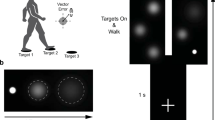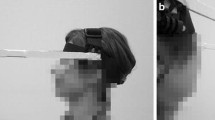Abstract
During locomotion, a top-down organization has been previously demonstrated with the head as a stabilized platform and gaze anticipating the horizontal direction of the trajectory. However, the quantitative assessment of the anticipatory sequence from gaze to trajectory and body segments has not been documented. The present paper provides a detailed investigation into the spatial and temporal anticipatory relationships among the direction of gaze and body segments during locomotion. Participants had to walk along several mentally simulated complex trajectories, without any visual cues indicating the trajectory to follow. The trajectory shapes were presented to the participants on a sheet of paper. Our study includes an analysis of the relationships between horizontal gaze anticipatory behavior direction and the upcoming changes in the trajectory. Our findings confirm the following: 1) The hierarchical ordered organization of gaze and body segment orientations during complex trajectories and free locomotion. Gaze direction anticipates the head orientation, and head orientation anticipates reorientation of the other body segments. 2) The influence of the curvature of the trajectory and constraints of the tasks on the temporal and spatial relationships between gaze and the body segments: Increased curvature resulted in increased time and spatial anticipation. 3) A different sequence of gaze movements at inflection points where gaze plans a much later segment of the trajectory.






Similar content being viewed by others
References
Anastasopoulos D, Ziavra N, Hollands M, Bronstein A (2009) Gaze displacement and inter-segmental coordination during large whole body voluntary rotations. Exp Brain Res 193:323–336
Bennequin D, Fuchs R, Berthoz A, Flash T (2009) Movement timing and invariance arise from several geometries. PLoS Comput Biol 5:e1000426
Billington J, Field DT, Wilkie RM, Wann JP (2010) An fMRI study of parietal cortex involvement in the visual guidance of locomotion. J Exp Psychol Hum Percept Perform 36:1495–1507
Cinelli ME, Patla AE, Allard F (2009) Behaviour and gaze analyses during a goal-directed locomotor task. Q J Exp Psychol 62(3):483–499
Courtine G, Schieppati M (2003) Human walking along a curved path. I. Body trajectory, segment orientation and the effect of vision. Eur J Neurosci 18:177–190
Crowell JA, Banks MS, Shenoy KV, Andersen RA (1998) Visual self-motion perception during head turns. Nat Neurosci 1:732–737
Field DT, Wilkie RM, Wann JP (2007) Neural systems in the visual control of steering. J Neurosci 27:8002–8010
Glasauer S, Amorim MA, Bloomberg JJ, Reschke MF, Peters BT, Smith SL, Berthoz A (1995) Spatial orientation during locomotion [correction of locomation] following space flight. Acta Astronaut 36:423–431
Glasauer S, Amorim MA, Viaud-Delmon I, Berthoz A (2002) Differential effects of labyrinthine dysfunction on distance and direction during blindfolded walking of a triangular path. Exp Brain Res 145:489–497
Gordon CR, Fletcher WA, Melvill JG, Block EW (1995) Adaptive plasticity in the control of locomotor trajectory. Exp Brain Res 102:540–545
Grasso R, Glasauer S, Takei Y, Berthoz A (1996) The predictive brain: anticipatory control of head direction for the steering of locomotion. NeuroReport 7:1170–1174
Grasso R, Prevost P, Ivanenko YP, Berthoz A (1998a) Eye-head coordination for the steering of locomotion in humans: an anticipatory synergy. Neurosci Lett 253:115–118
Grasso R, Assaiante C, Prevost P, Berthoz A (1998b) Development of anticipatory orienting strategies during locomotor tasks in children. Neurosci Biobehav Rev 22:533–539
Hicheur H, Vieilledent S, Berthoz A (2005) Head motion in humans alternating between straight and curved walking path: combination of stabilizing and anticipatory orienting mechanisms. Neurosci Lett 383:87–92
Hollands MA, Sorensen KL, Patla AE (2001) Effects of head immobilization on the coordination and control of head and body reorientation and translation during steering. Exp Brain Res 140:223–233
Hollands MA, Patla AE, Vickers JN (2002) “Look where you’re going!”: gaze behaviour associated with maintaining and changing the direction of locomotion. Exp Brain Res 143:221–230
Hollands MA, Ziavra NV, Bronstein AM (2004) A new paradigm to investigate the roles of head and eye movements in the coordination of whole-body movements. Exp Brain Res 154:261–266
Imai T, Moore ST, Raphan T, Cohen B (2001) Interaction of the body, head, and eyes during walking and turning. Exp Brain Res 136:1–18
Jahn K, Deutschlander A, Stephan T, Strupp M, Wiesmann M, Brandt T (2004) Brain activation patterns during imagined stance and locomotion in functional magnetic resonance imaging. Neuroimage 22:1722–1731
Johansson RS, Westling G, Backstrom A, Flanagan JR (2001) Eye-hand coordination in object manipulation. J Neurosci 21:6917–6932
Land MF, Lee DN (1994) Where we look when we steer. Nature 369:742–744
Loomis JM, Klatzky RL, Golledge RG, Cicinelli JG, Pellegrino JW, Fry PA (1993) Nonvisual navigation by blind and sighted: assessment of path integration ability. J Exp Psychol Gen 122:73–9122
Mergner T, Rosemeier T (1998) Interaction of vestibular, somatosensory and visual signals for postural control and motion perception under terrestrial and microgravity conditions–a conceptual model. Brain Res Brain Res Rev 28:118–135
Mergner T, Hlavacka F, Schweigart G (1993) Interaction of vestibular and proprioceptive inputs. J Vestib Res 3:41–57
Osaki Y, Kunin M, Cohen B, Raphan T (2008) Relative contribution of walking velocity and stepping frequency to the neural control of locomotion. Exp Brain Res 185:121–135
Patla AE, Vickers JN (1997) Where and when do we look as we approach and step over an obstacle in the travel path? NeuroReport 8:3661–3665
Patla AE, Adkin A, Ballard T (1999) Online steering: coordination and control of body center of mass, head and body reorientation. Exp Brain Res 129:629–634
Pham QC, Berthoz A, Hicheur H (2011) Invariance of locomotor trajectories across visual and gait direction conditions. Exp Brain Res 210:207–215
Pozzo T, Berthoz A, Lefort L (1990) Head stabilization during various locomotor tasks in humans. I. Normal subjects. Exp Brain Res 82:97–106
Pozzo T, Berthoz A, Lefort L, Vitte E (1991) Head stabilization during various locomotor tasks in humans. II. Patients with bilateral peripheral vestibular deficits. Exp Brain Res 85:208–217
Reed-Jones RJ, Hollands MA, Reed-Jones JG, Vallis LA (2009) Visually evoked whole-body turning responses during stepping in place in a virtual environment. Gait Posture 30:317–321
Reina GA, Schwartz AB (2003) Eye-hand coupling during closed-loop drawing: evidence of shared motor planning? Hum Mov Sci 22:137–152
Royden CS, Banks MS, Crowell JA (1992) The perception of heading during eye movements. Nature 360:583–585
Royden CS, Crowell JA, Banks MS (1994) Estimating heading during eye movements. Vision Res 34:3197–3214
Snyder LH (2000) Coordinate transformations for eye and arm movements in the brain. Curr Opin Neurobiol 10:747–754
Takei Y, Grasso R, Berthoz A (1996) Quantitative analysis of human walking trajectory on a circular path in darkness. Brain Res Bull 40:491–495
Takei Y, Grasso R, Amorim MA, Berthoz A (1997) Circular trajectory formation during blind locomotion: a test for path integration and motor memory. Exp Brain Res 115:361–368
Taylor MJ, Dabnichki P, Strike SC (2005) A three-dimensional biomechanical comparison between turning strategies during the stance phase of walking. Hum Mov Sci 24:558–573
Turano KA, Geruschat DR, Baker FH (2002) Fixation behavior while walking: persons with central visual field loss. Vision Res 42:2635–2644
Viviani P, Terzuolo C (1982) Trajectory determines movement dynamics. Neuroscience 7:431–437
Wagner J, Stephan T, Kalla R, Brückmann H, Strupp M, Brandt T, Jahn K (2008) Mind the bend—Cerebral activations associated with mental imagery of walking along a curved path. Exp Brain Res 191:247–255
Weber KD, Fletcher WA, Gordon CR, Melvill JG, Block EW (1998) Motor learning in the “podokinetic” system and its role in spatial orientation during locomotion. Exp Brain Res 120:377–385
Wilkie RM, Wann JP (2005) The role of visual and nonvisual information in the control of locomotion. J Exp Psychol Hum Percept Perform 31:901–911
Wilkie RM, Wann JP, Allison RS (2008) Active gaze, visual look-ahead, and locomotor control. J Exp Psychol Hum Percept Perform 34:1150–1164
Zhang T, Britten KH (2011) Parietal area VIP causally influences heading perception during pursuit eye movements. J Neurosci 31:2569–2575
Acknowledgments
This project was supported by the LOCANTHROPE ANR project and ROBOSOM project, and Neuropôle Ile de France—NEUROPACT project. D. Bernardin was supported by the French Public Transportation—RATP and ROBOSOM project. H. Kadone was supported by a position as Maitre de Conférence at the Collège de France. Expert technical assistance was provided by Mocaplab. The authors are grateful to Remy Brun and his team for help with data collection and to France Maloumian for help with illustration.
Author information
Authors and Affiliations
Corresponding authors
Rights and permissions
About this article
Cite this article
Bernardin, D., Kadone, H., Bennequin, D. et al. Gaze anticipation during human locomotion. Exp Brain Res 223, 65–78 (2012). https://doi.org/10.1007/s00221-012-3241-2
Received:
Accepted:
Published:
Issue Date:
DOI: https://doi.org/10.1007/s00221-012-3241-2




